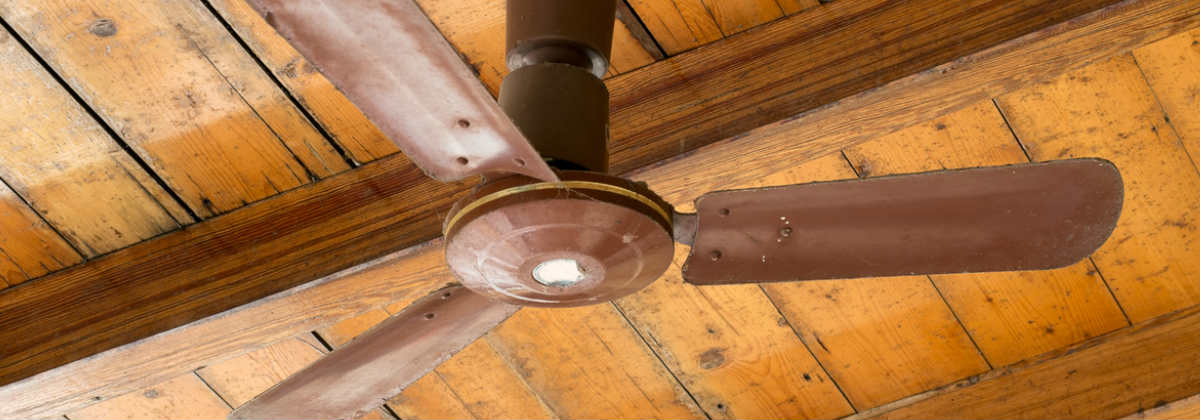Key points
The Australian summer can be unforgiving and for those without air conditioning, a ceiling fan is likely your best option. While ceiling fans might not be as effective at cooling as air conditioners, they do use considerably less energy. But, just how much electricity do they use, and are ceiling fans expensive to run? Canstar Blue has crunched the numbers so you can get to the bottom of ceiling fan running costs.
How much power does a ceiling fan use?
According to Canstar Blue data, the average indoor ceiling fan costs around 0.2c to 1.9c per hour to run, or between $1.44 and $13.68 over summer (90 days) if it were used eight hours per day. These costs, however, will depend on the fan’s speed settings, how frequently it’s used and the usage rate you pay for electricity. Like most electrical appliances, a ceiling fan’s power is measured in watts. The larger the fan, or the faster it needs to spin, the more watts of electricity it consumes – adding to your energy bill.
We’ve highlighted an hourly cost estimate for ceiling fans both with a DC motor and AC motor below. These tables assume a standard 48-52” blade, 3-speed to 5-speed fan with a maximum output of 58W in use.
How much does it cost to run a ceiling fan? (DC motor)
← Mobile/tablet users, scroll sideways to view full table →
| Fan Speed | Power (W) | Hourly Running Cost (c) | Summer Running Costs ($) |
|---|---|---|---|
| Low (60-94RPM) | 5 | 0.2 | 1.44 |
| Low – Medium (95-129RPM) | 8 | 0.3 | 2.16 |
| Medium (130-164RPM) | 15 | 0.5 | 3.60 |
| Medium – High (165-199RPM) | 21 | 0.7 | 5.04 |
| High (200-234RPM) | 28 | 0.9 | 6.48 |
Source: www.canstar.com.au – 05/12/24. Calculations assume a single-rate usage rate of 31.9c/kWh. Summer running costs assume a usage time of 8 hours a day, 90 days a year.
How much does it cost to run a ceiling fan? (AC motor)
← Mobile/tablet users, scroll sideways to view full table →
| Fan Speed | Power (W) | Hourly Running Cost (c) | Summer Running Costs ($) |
|---|---|---|---|
| Low (100-149RPM) | 17 | 0.5 | 3.60 |
| Medium (150-199RPM) | 39 | 1.2 | 8.64 |
| High (200-249RPM) | 58 | 1.9 | 13.68 |
Source: www.canstar.com.au – 05/12/24. Calculations assume a single-rate energy usage rate of 31.9c/kWh. Summer running costs assume a usage time of 8 hours a day, 90 days a year.
As you can see from the tables above, just one single fan is not particularly expensive, especially when used in moderation and operated at low speeds. That said, the costs could add up if you have multiple fans running, or if they are left on when no one is using them. This is something to keep in mind over the summer months, especially if you are concerned about the cooling costs of using an air conditioner in place of a ceiling fan.
Compare cheap electricity deals
While you’re reviewing energy costs, why not take the time to compare electricity plans in your area. We list some of the cheapest deals across NSW, VIC, QLD and SA, however it’s still best to use our comparison tool to see which deals are available in your postcode.
Here are some of the cheapest published deals from the retailers on our database that include a link to the retailer’s website for further details. These are products from referral partners†. These costs are based on the Ausgrid network in Sydney but prices may vary depending on your circumstances. This comparison assumes general energy usage of 3900kWh/year for a residential customer on a single rate tariff. Please use our comparison tool for a specific comparison in your area. Our database may not cover all deals in your area. As always, check all details of any plan directly with the retailer before making a purchase decision.
Here are some of the cheapest published deals from the retailers on our database that include a link to the retailer’s website for further details. These are products from referral partners†. These costs are based on the Citipower network in Melbourne but prices may vary depending on your circumstances. This comparison assumes general energy usage of 4000kWh/year for a residential customer on a single rate tariff. Please use our comparison tool for a specific comparison in your area. Our database may not cover all deals in your area. As always, check all details of any plan directly with the retailer before making a purchase decision.
Here are some of the cheapest published deals from the retailers on our database that include a link to the retailer’s website for further details. These are products from referral partners†. These costs are based on the Energex network in Brisbane but prices may vary depending on your circumstances. This comparison assumes general energy usage of 4600kWh/year for a residential customer on a single rate tariff. Please use our comparison tool for a specific comparison in your area. Our database may not cover all deals in your area. As always, check all details of any plan directly with the retailer before making a purchase decision.
Here are some of the cheapest published deals from the retailers on our database that include a link to the retailer’s website for further details. These are products from referral partners†. These costs are based on the SA Power network in Adelaide but prices may vary depending on your circumstances. This comparison assumes general energy usage of 4000kWh/year for a residential customer on a single rate tariff. Please use our comparison tool for a specific comparison in your area. Our database may not cover all deals in your area. As always, check all details of any plan directly with the retailer before making a purchase decision.
What can I do to reduce my summer cooling costs?
If you’ve found your way onto this ceiling fan guide, chances are you’re concerned about how much it costs to run a ceiling fan and other cooling appliances. So, what can you do to help reduce some of this summer power bill anxiety? We’ve listed some tips below:
- Use your ceiling fans: As shown in this very guide, ceiling fans are fairly cheap to run. Where possible, it may be smart to use a ceiling fan in place of air conditioning.
- Watch your air conditioner temperature: The temperature of your air conditioner will play a significant role in how much it costs you to run it. Try not to use your air conditioner on extremely low temperatures as this will increase running costs.
- Close gaps and keep the cool in: If you are running your air conditioner this summer, don’t let that precious cool air escape! Close any windows or doors to rooms you aren’t cooling. It will prove much more effective to contain the cooling to one area of the house if you have a split system.
Original article by Brendon O’Neill





Share this article